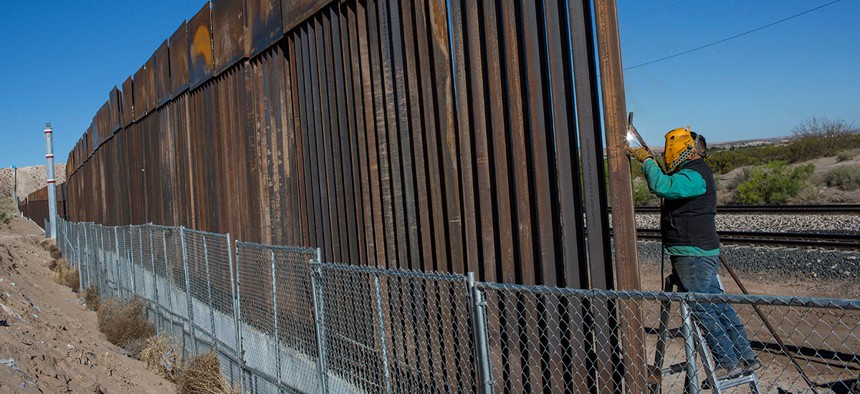
A worker welds a new fence between the Anapra neighborhood of Ciudad Juarez, Mexico, and Sunland Park, New Mexico, on March 30. Rodrigo Abd/AP
Trump's Border Barrier Hits a Wall
The administration would need to acquire private property to build his barricade, which will put the president at odds with many in his own party.
Pamela Taylor’s home in Brownsville, Texas, sits in between the Rio Grande and the current border fence. Taylor, 88, voted for Donald Trump. But now, she faces the possibility that the man she voted for could take her land through eminent domain.
“As far as we’re concerned, the fence is not going to work. This fence is not working,” she said. “When you’re not here and you don’t know the area and then you say something, it’s best to get your ducks in a row.” If the administration were to present her a condemnation notice, she told me she would “definitely” take it to court.
Taylor is one of many landowners along the Texas-Mexico border who are preparing for a legal fight to keep their property. In 2006, President George W. Bush signed the Secure Fence Act, authorizing the construction of 700 miles of fencing along the U.S.-Mexico border. The administration focused on states where most of the land belonged to the government. But in some areas, the government needed to acquire private property in order to build on it. Some landowners, unhappy with imposing barriers, protested. As Trump attempts to jumpstart the process of sealing the southern border, he will face similar resistance.
In January, Trump signed an executive order calling for the construction of a wall—a project estimated to cost as much as $21.6 billion, according to the Department of Homeland Security. Building a physical barrier along the border is a tall order: it stretches roughly 2,000 miles, and the topography in some areas can also pose a challenge. The territory that Trump intends to cover also includes private property—a factor that doesn’t appear to have gone unnoticed by the administration.
In his budget blueprint, Trump requested funding for 20 additional Justice Department lawyers “to pursue federal efforts to obtain the land and holdings necessary to secure the Southwest border.” This sets up the use of eminent domain, which allows the government to acquire privately owned land if it’s for public use. It also, however, puts the president at odds with his own party, which has long argued that the use of eminent domain is an example of big government overreach.
During the presidential campaign, Trump hailed eminent domain as “necessary” for the country. The note of praise was not unusual for Trump, who has taken advantage of eminent domain as a businessman, but it sidestepped the Republican Party’s position on the matter.
In 2005, the U.S. Supreme Court expanded the “public use” component in the Fifth Amendment’s Takings Clause—citizens cannot “be deprived of life, liberty, or property, without due process of law; nor shall private property be taken for public use, without just compensation”—allowing a local government to seize property from private landowners and turn it over to a private developer. Trump has defended the ruling.
Republicans, however, have tried to override the decision in recent years. In 2013, Representative Jim Sensenbrenner of Wisconsin introduced the Private Property Rights Protection Act. It prohibits state and local governments from using eminent domain “to transfer private property to other private parties for the purpose of economic development,” or otherwise be temporarily stripped of their federal funds. It also prohibits the federal government from doing so. The bill passed the House, but stalled in the Senate Judiciary Committee. Sensenbrenner has since reintroduced the bill.
“The freedom to own and protect one’s private property is foundational to our country. Congress must fight to protect the private property rights of Americans and reform the use and abuse of eminent domain,” Sensenbrenner said in a statement last month.
Now, with Trump in the White House, Republicans are faced with a conundrum as the president signals his intent to use eminent domain to construct his proposed border wall.
“I’ve said since 2013 that building a wall from sea to shining sea is the most expensive and least effective way to secure the border. Of particular concern, is that we’ve seen no estimates to date that include the total costs of land acquisition (as would be required through eminent domain) or of subsequent legal battles with landowners,” Representative Will Hurd, who represents over 820 miles of the U.S.-Mexico border, said in an emailed statement.
“If they’re building a wall in Texas, it means they are building on private land, which means it’s harder, a lot harder,” Representative John Carter of Texas told My Statesman. Carter has been in contact with White House officials over the challenges likely to arise from building a wall on the border.
Other Texas lawmakers also appear to share concerns about the erection of a wall. A delegation-wide survey conducted by The Texas Tribune last December found that some Texas Republicans in Congress support building a wall, though they “declined to clarify whether it should be a contiguous construction from San Diego to Brownsville.” Constituents of some of these Republican lawmakers would be at risk of having their land seized, potentially causing a backlash within their districts.
Texas Attorney General Ken Paxton told The Dallas Morning News that he’d be OK with the Trump administration using eminent domain to construct the border wall so long as people are “paid fairly.” Paxton, a Republican, noted that eminent domain has been used regularly for infrastructure projects. “In my mind, this is a very similar purpose,” he said. “It’s a public purpose providing safety to people not only along the border, but to the entire nation.”
Democrats also have concerns about the government purchasing private property to build a wall. “Private property rights and allowing big government to take this land that sometimes [residents have] owned for generations is something that we take very seriously here in Texas,” said Representative Henry Cuellar of Texas, who represents a district that lines the border.
The Texas Civil Rights Project, a legal advocacy group, has already begun preparing for eminent-domain cases. The group has experience to draw from—they represented some landowners in 2007 and 2008, said Efrén Olivares, the racial and economic justice director at the Texas Civil Rights Project. In all of the cases, landowners received more money than the government had initially proposed. But contrary to the Bush administration, Trump wants to seal the entire border, therefore putting more landowners at risk of receiving so-called condemnation notices.
“We have started contacting some landowners who are along the border whose land was partially taken or attempted to be taken back in ’07 and ’08,” Olivares said, adding that they plan to contact—and represent—as many landowners as possible.
Landowners are notified of the government’s intent to acquire their property in a condemnation notice. Landowners then have the right to request a jury trial, Olivares said. “The question for a jury is what constitutes just compensation.” He added: “You can also contest the taking itself but that is a difficult argument. In these border cases, the government surely will argue that they need to take the land for national security purposes so that’s a difficult argument to counter.” The cases are time consuming. There are still about 90 condemnation cases open from the last time the government tried to seize land, according to the Justice Department.
Government attempts to seize property are a particularly sensitive issue for residents who have owned their land for decades—a common case in the state of Texas.
“Property rights are important to all Americans—especially Texans—and most of the property along our border has been privately held for generation,” Hurd said in an email. “Many Texans I speak to think there are better ways to achieve border security without taking their lands, so you can expect a lengthy and expensive fight from these folks.” The government has not issued any new condemnation notices related to Trump’s proposed border wall, according to the Justice Department.
There’s much to be done before a wall along the U.S.-Mexico border is a done deal. Congress, after all, still needs to approve the funds. But even if it does, there’s a lot of Texan conservatives who will be standing in their way.







